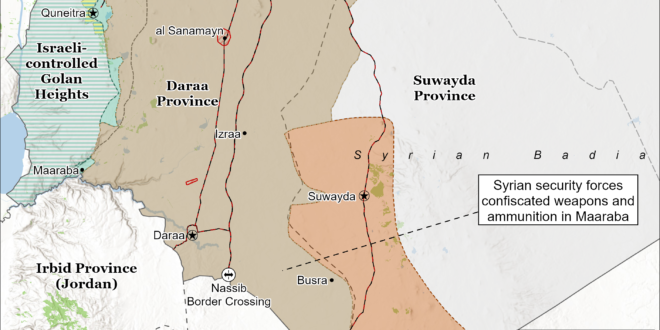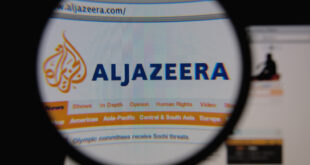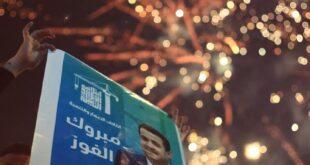The Critical Threats Project (CTP) at the American Enterprise Institute and the Institute for the Study of War (ISW) publish the Iran Update, which provides insights into Iranian and Iranian-sponsored activities that undermine regional stability and threaten US forces and interests. CTP-ISW publishes the Iran Update every weekday.
Click here to see CTP and ISW’s interactive map of the ongoing opposition offensive in Syria, and here to see CTP and ISW’s interactive map of Israeli ground operations. The Syria map is updated daily alongside the static Syria maps in this report. CTP-ISW ended daily maps of Israeli ground operations in February 2025.
We do not report in detail on war crimes because these activities are well-covered in Western media and do not directly affect the military operations we are assessing and forecasting. We utterly condemn violations of the laws of armed conflict and the Geneva Conventions and crimes against humanity even though we do not describe them in these reports.
Senior Iranian political and military officials, including Supreme Leader Ali Khamenei, met with Saudi Defense Minister Khalid bin Salman in Tehran on April 17. Saudi Arabia may seek to reassure Iran about its positions on a potential strike on Iran and a potential ground offensive against the Houthis in Yemen.[i] Salman’s visit to Iran follows recent statements by senior Iranian officials threatening to attack any base “used by Americans” in a potential strike on Iran.[ii] These threats likely seek to discourage US partners in the Middle East, including Saudi Arabia, from supporting an attack on Iran. Iran previously threatened in October 2024 that it would attack Saudi energy infrastructure if Saudi Arabia supported an Israeli attack on Iran.[iii] Salman may have sought to reassure Iranian officials that Saudi Arabia would not support an attack on Iran.
Salman, accompanied by Saudi Ambassador to Yemen Mohammed al Jaber, may have also sought to reassure Iran that Saudi Arabia would not support a ground offensive against the Houthis in Yemen.[iv] Salman’s visit to Iran follows recent reports that some Gulf countries and anti-Houthi factions in Yemen are exploring the possibility of a Yemeni government ground offensive against the Houthis.[v] Unspecified Saudi officials told Western media on April 14 that Saudi Arabia would not participate in a ground offensive.[vi] Iran views the Houthis as an integral part of the Axis of Resistance, particularly since Israel has significantly degraded other key members of the Axis of Resistance, including Hezbollah and Hamas.[vii]
A Chinese government-linked satellite company provided intelligence to the Houthis, according to US officials speaking to the Financial Times on April 17.[viii] This intelligence could support Houthi attacks against US vessels and commercial shipping, which demonstrates how the Houthis are continuing to cooperate with US adversaries to disrupt global trade. The US government raised concerns to the Chinese government about Chang Guang Satellite Technology Co., Ltd. (CGSTL) providing satellite intelligence to the Houthis.[ix] The Chinese government reportedly ignored these concerns. CGSTL has ties to the Chinese military through China’s military-civilian “fusion” program, which aims to integrate private sector work with military research and development, according to research done by a Washington-based security consulting firm.[x] CGSTL’s provision of satellite intelligence to the Houthis is part of ongoing Chinese, Russian, and Iranian support to the Houthis. Houthi-owned military communications and domestic surveillance companies have reportedly imported Chinese-made communications equipment.[xi] Iran and Russia have provided targeting intelligence to the Houthis, which aids Houthi attacks on international shipping.[xii] The Yemeni coast guard and Omani customs have previously seized shipments of Chinese-made military equipment to the Houthis, such as hydrogen fuel cells for powering missiles and drone propellers.[xiii] The Houthis reportedly told China and Russia in March 2024 that the Houthis would not target Chinese and Russian-flagged vessels transiting the Red Sea, according to several sources with knowledge on Houthi leadership discussions.
The United Arab Emirates (UAE) deployed an Israeli EL/M-2084 radar at the Emirati Bosaso military base on the coast of the autonomous Puntland region of northern Somalia.[xiv] The UAE reportedly replaced an older radar system with the new EL/M-2084, which has a range of 256 nautical miles.[xv] The UAE could use this radar to detect various types of projectiles, including low-flying drones and high-altitude ballistic missiles, over the Gulf of Aden.[xvi] The UAE could also use the radar to detect Houthi attacks on internationally-recognized Yemeni government targets, such as gas and oil export terminals in southern Yemen that the Houthis have previously targeted.[xvii] These energy export terminals are the internationally-recognized Yemeni government’s economic lifeline.[xviii]
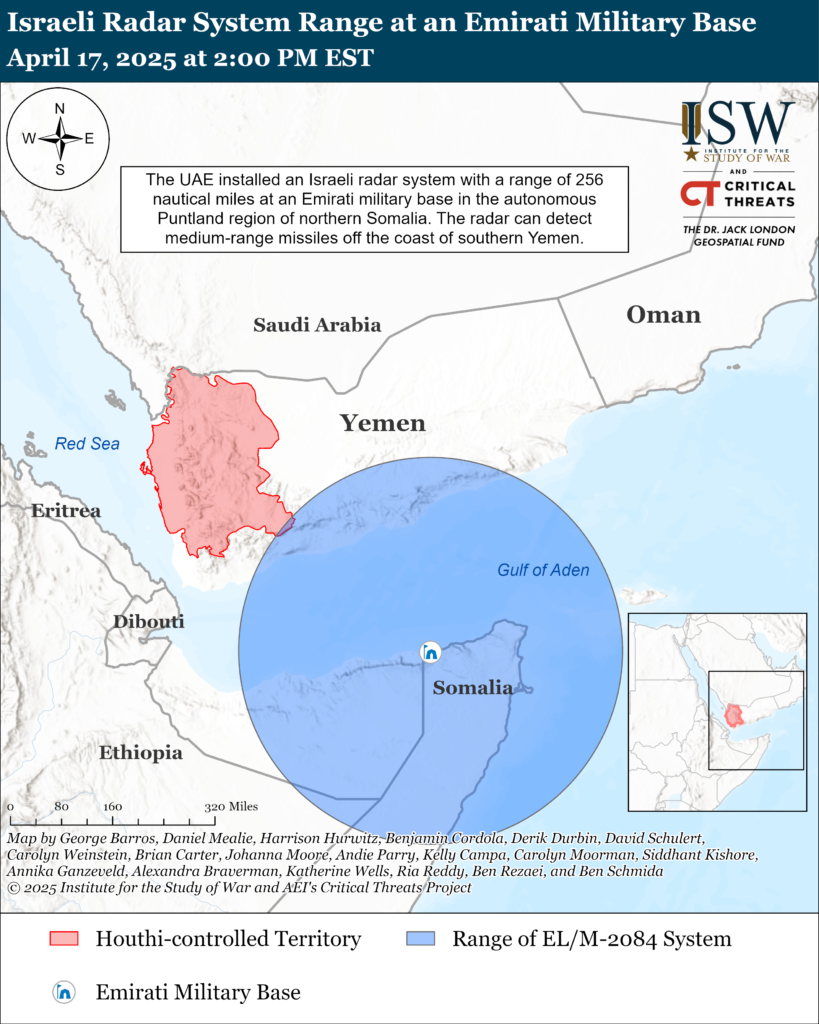
The United States reportedly asked the Syrian transitional government in mid-March to end Palestinian political and militia activity in Syria in exchange for partial sanctions relief.[xix] The Washington Post reviewed a list of eight “confidence-building” conditions that US Deputy Assistant Secretary for the Levant and Syria Natasha Franceschi delivered to Syrian Foreign Minister Asaad al Shaibani in Brussels on March 18.[xx] The United States is considering extending an existing sanctions exemption by two years and possibly issuing another sanctions exemption if the Syrian transitional government fulfills these conditions, according to six unspecified US and Syrian sources.[xxi] The US Department of State and Department of the Treasury confirmed in early April that they were considering further “waivers, licenses, and assistance from foreign partners and allies” for Syria.[xxii] The list of conditions includes counterterrorism cooperation between the US and Syrian governments, the destruction of any remaining chemical weapons stockpiles, the appointment of a liaison to assist efforts to find missing US citizen Austin Tice, and the prevention of foreign fighters’ appointments to “senior roles in Syria’s governing structure.”[xxiii] CTP-ISW previously assessed that Syrian President Ahmed al Shara will likely oppose the condition to bar foreign fighters from senior government positions given that this condition would require him to sideline individuals who are deeply loyal to him.[xxiv] The United States also called on the Syrian government to “issue a formal public declaration banning all Palestinian militias and political activities” and to deport members of these Palestinian groups.[xxv] Shara is unlikely to be willing or able to ban all Palestinian political activity in Syria but could agree to expel Palestinian militias from Syria in exchange for sanctions relief. The Iranian-led Axis of Resistance, which includes Palestinian militias such as Hamas and Palestinian Islamic Jihad, has sought to destabilize the new Syrian government and weaken the government’s control over Syria.[xxvi] It is unclear how many Palestinian militias currently operate in Syria given that the Syrian government has largely expelled other Axis of Resistance militias, such as Lebanese Hezbollah, from Syria since the fall of the Assad regime in December 2024.[xxvii]
Russian President Vladimir Putin has continued to indicate that he seeks to develop stronger diplomatic and political relations with the Syrian transitional government. Russian President Vladimir Putin discussed Russian interests in Syria with Qatari Emir Tamim bin Hamad bin Khalifa al Thani in Moscow on April 17.[xxviii] Putin emphasized that Russia supports Syrian sovereignty, independence, and territorial integrity and discussed providing aid to Syria with Thani.[xxix] Russia and the Syrian transitional government have engaged in months-long talks over the future of Russian bases in Syria. These talks have thus far not resulted in an agreement about Russian basing rights in Syria. Russia appears to have begun an incentives-based economic relationship with Syria and has delivered Syrian currency and Russian oil to Syria.[xxx] Russia also reportedly seeks to re-negotiate Russian investment contracts for phosphate mines and oil fields in the central Syrian desert.[xxxi] CTP-ISW previously assessed that Russia might try to use these economic incentives to secure basing rights in Syria.[xxxii] Thani said during a joint press conference with Putin that he and Syrian President Ahmed al Shara discussed Russo-Syrian relations during Shara’s visit to Qatar on April 15 and that Shara is “determined to continue this cooperation.”[xxxiii]
Syrian media reported that Russian forces remain present at three military bases in Syria: Hmeimim airbase in Latakia, the naval base at Tartus, and Russia’s former helicopter base in Qamishli, Hasakah Province.[xxxiv] The Syrian government and SDF likely permitted Russia to maintain limited forces at these bases while negotiations have continued since December 2024. Russia’s presence at Hmeimim and Tartus has generated significant attention given their relevance to Russian strategic objectives in the Mediterranean Sea, but Syrian media reported that a likely small contingent of Russian forces also remain at Qamishli, which is located in SDF-held territory.[xxxv] A Kurdish source posted a video on April 17 that showed a Russian An-72 transport aircraft on Qamishli’s airstrip.[xxxvi] Two Russian-flagged vehicles approached the aircraft.[xxxvii] SDF Commander Mazloum Abdi stated on April 14 that a Russian presence at Qamishli was “not a concern” and that Shara appears to be considering allowing Russia to maintain its force presence in Syria under a new agreement.[xxxviii]
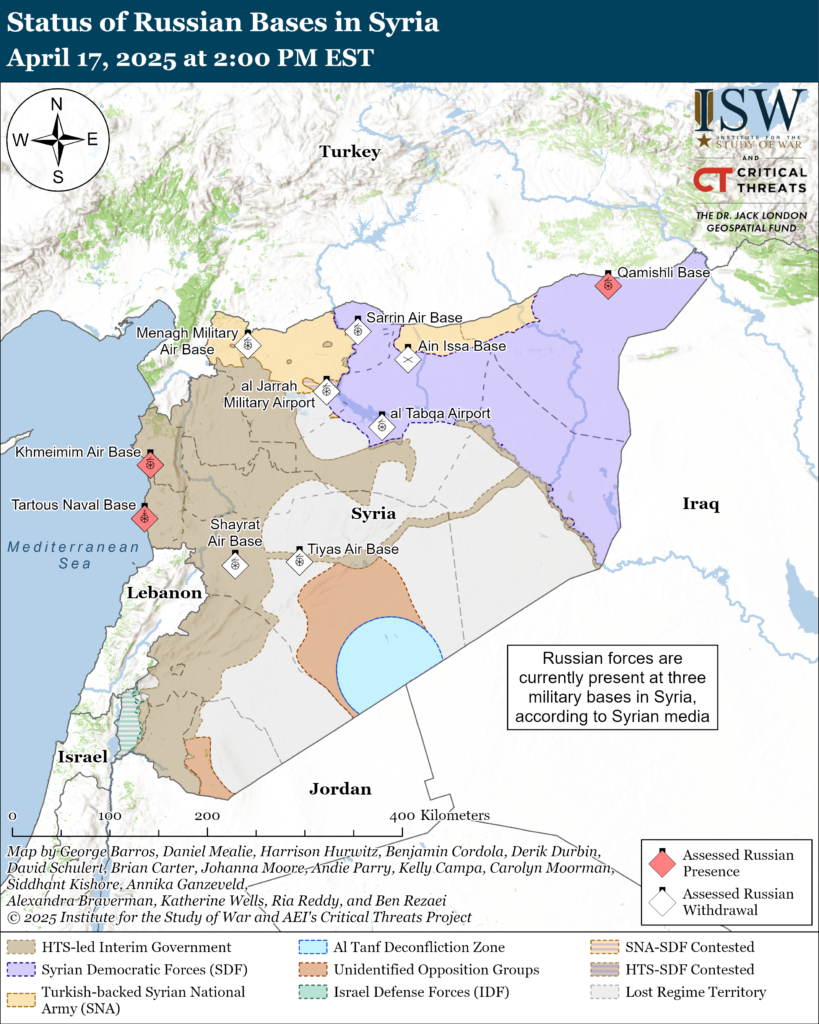
Key Takeaways:
Saudi Defense Minister in Iran: Senior Iranian political and military officials, including Supreme Leader Ali Khamenei, met with Saudi Defense Minister Khalid bin Salman in Tehran on April 17. Salman may have sought to reassure Iranian officials that Saudi Arabia would not support an attack on Iran. Salman, accompanied by Saudi Ambassador to Yemen Mohammed al Jaber, may have also sought to reassure Iran that Saudi Arabia would not support a ground offensive against the Houthis in Yemen.
China-Houthi Cooperation: A Chinese government-linked satellite company provided intelligence to the Houthis, according to US officials speaking to the Financial Times on April 17. This intelligence could support Houthi attacks against US vessels and commercial shipping, which demonstrates how the Houthis are continuing to cooperate with US adversaries to disrupt global trade.
US Sanctions Relief for Syria: The United States reportedly asked the Syrian transitional government in mid-March to end Palestinian political and militia activity in Syria in exchange for partial sanctions relief. Syrian President Ahmed al Shara is unlikely to be willing or able to ban all Palestinian political activity in Syria but could agree to expel Palestinian militias from Syria in exchange for sanctions relief. The Iranian-led Axis of Resistance, which includes Palestinian militias such as Hamas and Palestinian Islamic Jihad, has sought to destabilize the new Syrian government and weaken the government’s control over Syria.
Russian Cooperation with the Syrian Transitional Government: Russian President Vladimir Putin has continued to indicate that he seeks to develop stronger diplomatic and political relations with the Syrian transitional government. Russian President Vladimir Putin discussed Russian interests in Syria with Qatari Emir Tamim bin Hamad bin Khalifa al Thani in Moscow on April 17. CTP-ISW previously assessed that Russia might try to use economic incentives to secure basing rights in Syria.
Syria
Anti-Syrian government social media accounts claimed on April 16 that General Security Services (GSS) personnel intimidated villagers in rural Latakia Province to give false testimonies to the commission investigating the March 2025 violence on the Syrian coast.[xxxix] GSS personnel reportedly instructed al Mukhtariya residents to deny government involvement in the early March civilian massacres and to blame pro-Assad insurgents instead. The villagers reportedly disregarded these threats and instead implicated the GSS for committing massacres in their testimonies to the committee.[xl] At least 40 civilians died in al Mukhtariya during the pro-Assad insurgent uprising in early March.[xli] The residents reportedly fled al Mukhtariya after testifying before the commission due to fear of GSS retaliation.[xlii] CTP-ISW cannot independently verify the claims made by these anti-government social media accounts, which regularly promote Assadist views. The commission spokesperson, Yasser al Farhan, stated on March 25 that the commission had completed its visits to all areas in Latakia Province that had experienced violence and was expanding its investigation to other provinces.[xliii] It is unclear whether the commission has returned to Latakia Province since March 25 to conduct investigations. The reports about GSS intimidation, if accurate, will erode public trust in the commission and risk discrediting its findings as partial or compromised. The committee must prevent any group from intimidating families in order to avoid obscuring the commission’s findings.
GSS forces confiscated weapons and pursued wanted individuals in Maaraba, Daraa Province, on April 17.[xliv] Authorities urged residents to surrender their weapons to the GSS via mosque loudspeakers.[xlv] GSS forces seized several illegal vehicles, small arms, and various types of ammunition.[xlvi] Security forces have confiscated weapons and military equipment in Busra al Sham, west of Maaraba, and its surrounding countryside since the dissolution of the Eighth Brigade on April 13.[xlvii] CTP-ISW previously assessed that the transitional government appears to be trying to reduce the Eighth Brigade’s influence over security in southeastern Daraa.[xlviii]

Syrian President Ahmed al Shara and Foreign Minister Asaad al Shaibani met with Jordanian Foreign Minister Ayman Safadi in Damascus on April 17.[xlix] Safadi and Shaibani agreed to form a council to coordinate cooperation in various sectors, including the economy, energy, transportation, and technology.[l] The council plans to hold its first meeting in the coming weeks.[li] Syria and Jordan previously agreed on January 7 to form several coordination committees.[lii] Shaibani also discussed strengthening security cooperation, particularly in regard to regional counter-ISIS efforts and efforts to combat drug and arms smuggling along the Syria-Jordan border.[liii] Safadi reaffirmed Jordan’s support for Syria’s reconstruction process and its overall security.[liv] Safadi emphasized that ongoing Israeli strikes and activity in southern Syria violate the 1974 Disengagement Agreement and increases regional tensions.[lv]
Kurdish leaders have continued to advocate for a decentralized governance system in Syria amid Turkey’s rejection of federalism in Syria. Syrian Democratic Council co-chairman Ali Rahmoun said on April 15 that Kurdish parties have entered talks with the Syrian transitional government in the hope of establishing a “form of self-administration or decentralization.”[lvi] The Autonomous Administration of North and East Syria (AANES) Foreign Relations co-chairwoman Ilham Ahmed advocated for a “decentralized system” in Syria on April 17.[lvii] Ahmed also noted that AANES is holding talks with Turkey, which AANES perceives will influence its talks with Damascus.[lviii] Turkish Foreign Minister Hakan Fidan said on April 17 that Ankara could not accept a “federal structure in Syria,” which suggests that the AANES-Turkey talks, in part, revolve around decentralization.[lix]
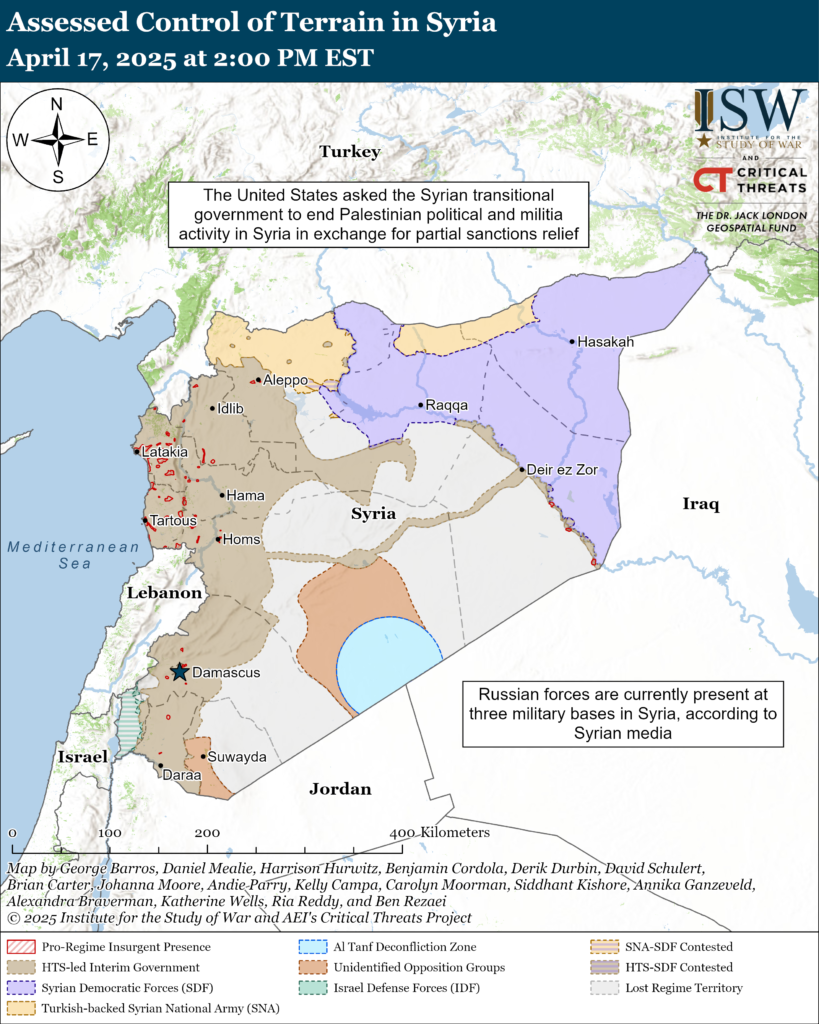
Iraq
Axis of Resistance objectives:
Strengthen Iranian and Axis of Resistance influence over the Iraqi state and society
Harden the Iraqi government against internal dissent
The secretary general of Iranian-backed Iraqi militia Kataib Sayyid al Shuhada, Abu Alaa al Walai, threatened on April 16 to attack a Turkish base in Ninewa Province, Iraq, if the Iraqi federal government does not take “necessary action” against the base[lx] Iranian-backed Iraqi militias have historically attacked Zilkan base in Bashiqa, Ninewa Province, and other Turkish positions in northern Iraq when they oppose Turkish regional activities.[lxi] Iran and Iranian-backed Iraqi actors have recently expressed concern about Turkey’s regional influence, particularly after the fall of the Assad regime in Syria.[lxii] Multiple Iraqi parliamentarians affiliated with Iranian-backed Iraqi militias urged the Iraqi federal government on April 15 to investigate several Sunni groups in Kirkuk and Ninewa provinces for their alleged ties to Turkey, for example.[lxiii]
Arabian Peninsula
Axis of Resistance objectives:
Harden the Houthi regime against internal dissent in Houthi-controlled areas
Destroy the anti-Houthi opposition in order to control all of Yemen
Erode Israeli will to continue the war in the Gaza Strip
US Central Command (CENTCOM) has conducted at least 30 airstrikes targeting Houthi infrastructure and leadership in Houthi-controlled areas of Yemen since April 16.[lxiv] CENTCOM conducted at least 14 airstrikes targeting Houthi underground facilities and weapons depots in Mount Nuqum, which is located on the eastern outskirts of Sanaa City.[lxv] CENTCOM also conducted at least six other airstrikes in Sanaa Governorate.[lxvi] One of these airstrikes targeted a building in central Sanaa City, reportedly killing an unspecified number of Houthi fighters.[lxvii] CENTCOM also conducted at least two airstrikes targeting Houthi supply lines between Sanaa City and the Houthis’ eastern front.[lxviii] CENTCOM separately conducted at least 10 airstrikes in Hudaydah Governorate, with seven targeting al Tuhayta axis on the Houthis’ southwestern front.[lxix]

The United States sanctioned the Sanaa-based International Bank of Yemen (IBY) and three IBY officials on April 17 for financially supporting the Houthis.[lxx] The US Department of the Treasury noted that the sanctions are part of the US effort to stop the Houthis from attacking commercial shipping in the Red Sea.[lxxi] The Houthis recently imposed a travel restriction on all government and private banking employees to prevent them from leaving Houthi-controlled areas after Sanaa-based banks announced that they would relocate to Yemeni government-controlled Aden to avoid being subject to US sanctions.[lxxii]
The Palestinian Territories and Lebanon
Axis of Resistance objectives:
Erode the will of the Israeli political establishment and public to sustain clearing operations in the Gaza Strip
Reestablish Hamas as the governing authority in the Gaza Strip
Rebuild and reestablish Hezbollah in southern Lebanon
Establish the West Bank as a viable front against Israel
The Lebanese Armed Forces (LAF) arrested a Lebanese national and a Palestinian with ties to Hamas on April 16 for their involvement in the March 22 and 28 attempted rocket attacks targeting Israel.[lxxiii] A senior Lebanese security official told the Wall Street Journal on April 16 that the LAF is searching for four other individuals who participated in the attacks. These individuals are likely hiding in Palestinian refugee camps in Lebanon, according to the official.[lxxiv] Hezbollah has denied involvement in both attacks.[lxxv] Rocket attacks by smaller, non-Hezbollah armed factions in southern Lebanon indicate that Hezbollah is badly degraded in southern Lebanon and lacks command and control there. Hezbollah has historically maintained de facto security control over southern Lebanon and the smaller armed factions that operate there, and it would likely be able to prevent attacks by smaller, non-Hezbollah groups if it were not badly degraded.
CTP-ISW will not be covering the new Israeli operation in the Gaza Strip. We have reprioritized our Middle East coverage to focus on Iran’s nuclear program, Iranian domestic security, and Iranian efforts to rebuild its networks into the Levant, including the Palestinian Territories. Given that Israel and its partners have destroyed Hamas’ military organization and severed the group’s ability to resupply itself, we are now focused on how Iran seeks to rebuild its lines of communication with Hezbollah and Hamas through Syria.
Iranian Decision-Making, Internal Dynamics, and Foreign Policy
The Iranian rial appreciated from 875,000 rials to one US dollar on April 16 to 856,000 rials to one US dollar on April 17.[lxxvi]
International Atomic Energy Agency (IAEA) Director General Rafael Grossi met with senior Iranian officials in Tehran on April 16 and 17 to discuss the Iranian nuclear program and the US-Iran nuclear talks.[lxxvii] Grossi stated that the IAEA is in contact with US negotiators to discuss how the agency can serve as a bridge between Iran and the United States and help achieve a positive outcome in the talks.[lxxviii] Iranian Foreign Affairs Minister Abbas Araghchi stated that the IAEA can play an important role in peacefully resolving the Iranian nuclear issue.[lxxix] Araghchi called on the IAEA “to take a clear stance” against recent threats to the Iranian nuclear program.[lxxx] Grossi told French media before traveling to Iran on April 16 that Iran is “not far” from possessing nuclear weapons.[lxxxi]
Iranian Foreign Affairs Minister Abbas Araghchi met with Russian President Vladimir Putin in Moscow on April 17 and delivered a message from Supreme Leader Ali Khamenei to Putin.[lxxxii] Araghchi stated that Khamenei’s message addressed important regional and international developments as well as bilateral issues.[lxxxiii] Araghchi emphasized that Russo-Iranian relations are stronger and more respectful than ever before and noted that the recently-signed Comprehensive Strategic Partnership Agreement elevated the relationship between Iran and Russia to a strategic level.[lxxxiv] Araghchi emphasized the importance of close coordination with Russia and China on the Iranian nuclear issue.[lxxxv] Iran, China, and Russia issued a joint statement on March 14 that condemned US sanctions on Iran and defended the Iranian nuclear program “as peaceful.”[lxxxvi]
The Iran Update provides insights into Iranian and Iranian-sponsored activities abroad that undermine regional stability and threaten US forces and interests. It also covers events and trends that affect the stability and decision-making of the Iranian regime. The Critical Threats Project (CTP) at the American Enterprise Institute and the Institute for the Study of War (ISW) provides these updates regularly based on regional events.
CTP-ISW defines the “Axis of Resistance” as the unconventional alliance that Iran has cultivated in the Middle East since the Islamic Republic came to power in 1979. This transnational coalition is comprised of state, semi-state, and non-state actors that cooperate to secure their collective interests. Tehran considers itself to be both part of the alliance and its leader. Iran furnishes these groups with varying levels of financial, military, and political support in exchange for some degree of influence or control over their actions. Some are traditional proxies that are highly responsive to Iranian direction, while others are partners over which Iran exerts more limited influence. Members of the Axis of Resistance are united by their grand strategic objectives, which include eroding and eventually expelling American influence from the Middle East, destroying the Israeli state, or both. Pursuing these objectives and supporting the Axis of Resistance to those ends have become cornerstones of Iranian regional strategy.
 Eurasia Press & News
Eurasia Press & News
